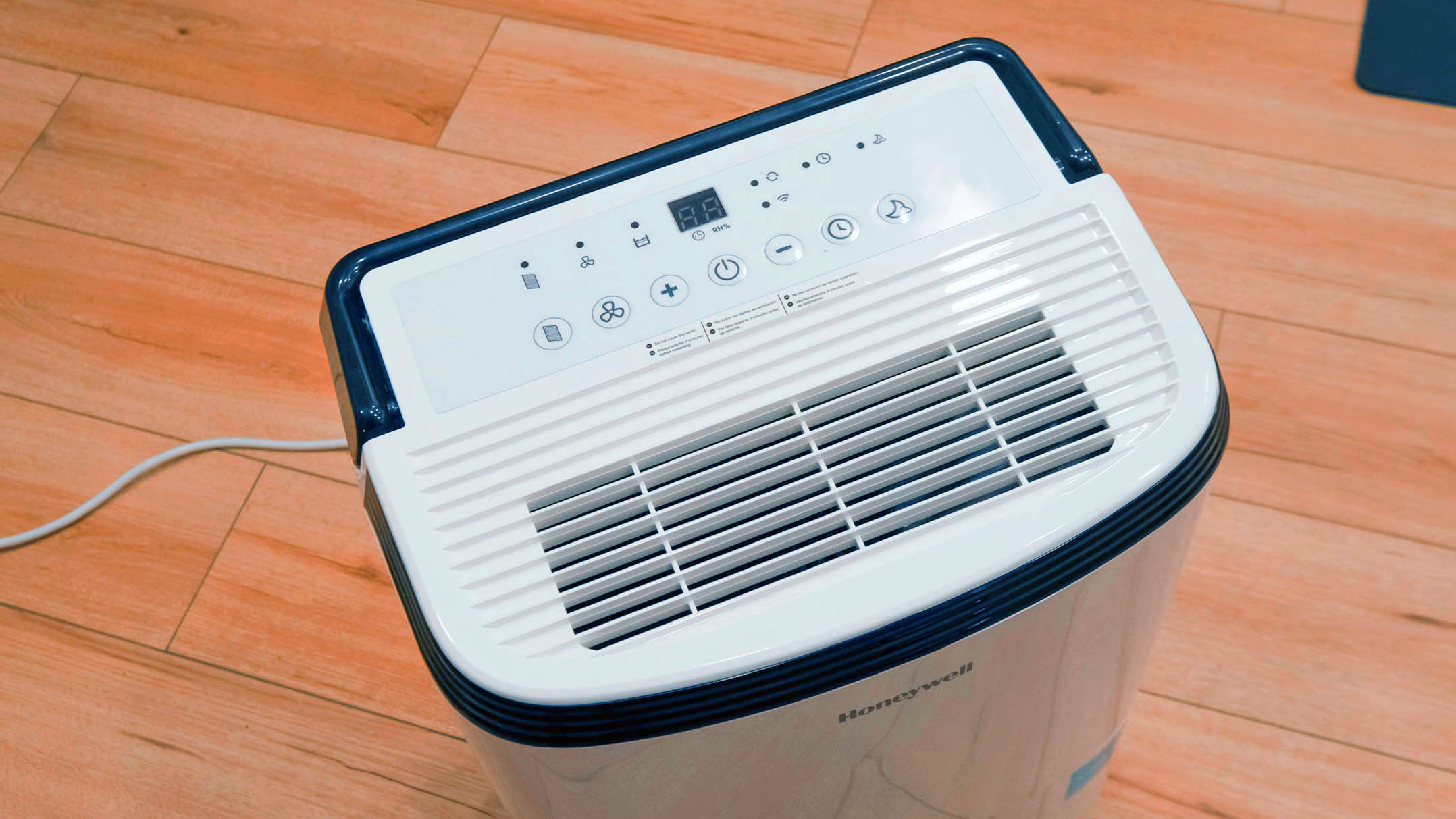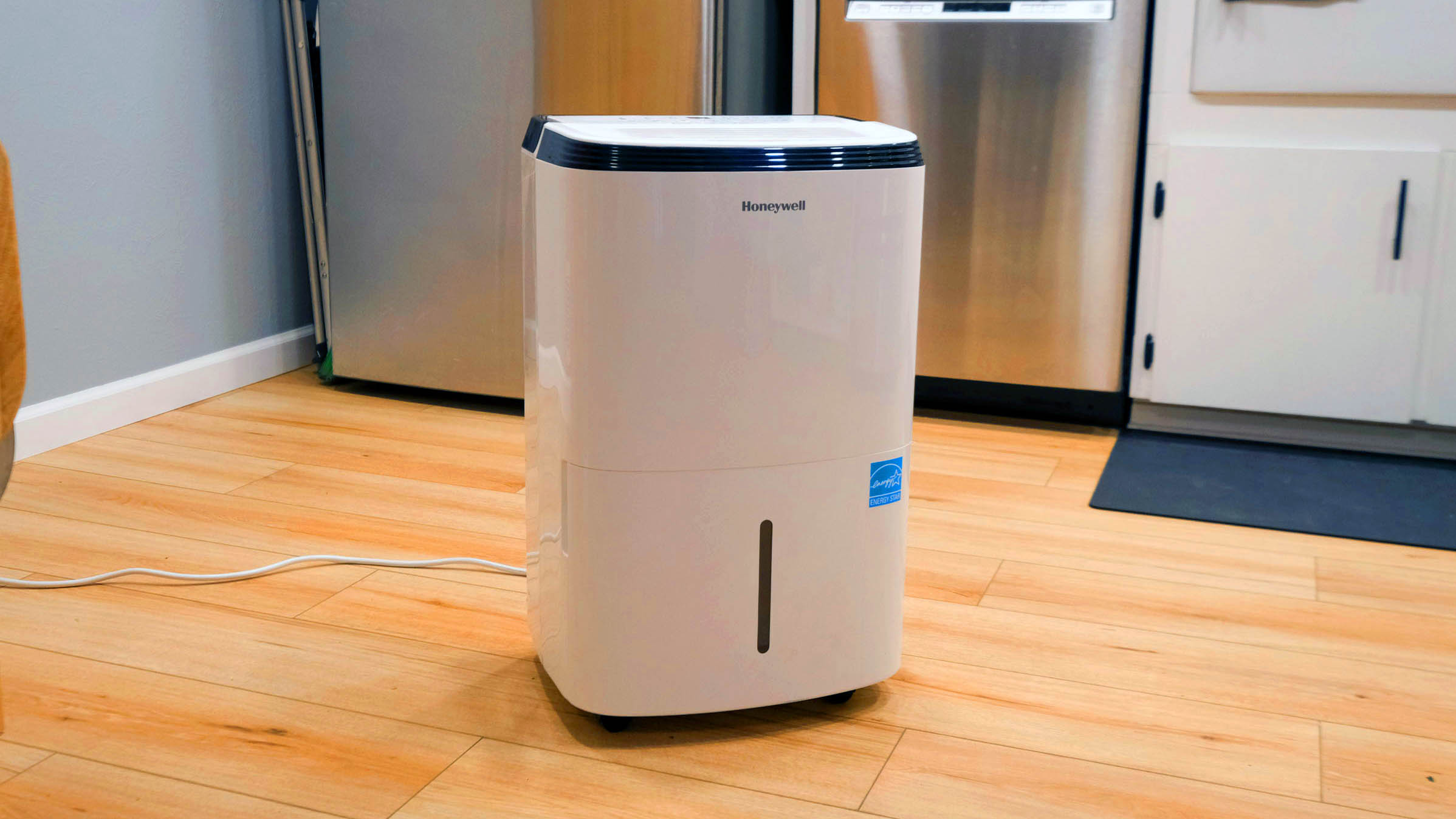Dehumidifier vs moisture absorber — what’s the difference?
If you want to prevent dampness and mold fast, here’s everything you need to know


The Frigidaire FGAC5044W1 has an excellent 50-pint capacity and advanced smart connectivity for automation and voice control via Alexa or Google. You can operate it remotely via the app, set the target humidity and receive notifications when the bucket is full.

This 15.8-Ounce moisture absorber effectively removes excess moisture from the air. It also eliminates bad odors and lasts up to 60 days and comes with four tablets. What’s more, it's available unscented or with a fresh scent and is safe around children and pets.
Whether you’re dealing with damp and condensation or wish to prevent mold in your home, there are quick solutions to reduce moisture levels in the air. And you might be wondering whether having one of the best dehumidifiers or a moisture absorber would be more suitable for your needs.
Essentially, both devices do the same thing — they draw in moisture from the air and capture it inside the appliance to reduce condensation and dampness in the room. However, there are key differences between the two products. We take a closer look to see how they compare regarding efficiency, ease of use, and of course, price to see which one might be more suitable for your home.
Dehumidifier vs moisture absorber — how do they work?

The main difference is that dehumidifiers are electric machines and require a power supply, while moisture absorbers are non-electric and can be placed anywhere in the home.
Typically, a dehumidifier works by circulating the air while pulling out moisture to dry out a room. There are two types — a compressor dehumidifier that draws moisture over a coil cooled to a very low temperature by a refrigeration system. Or a desiccant dehumidifier that draws moisture in over a filter and passes over an absorbent material called Zeolite. Once saturated, an internal heater or fan will blow warm dry air across the Zeolite, condensing the moisture into water which is collected into a tank. Compressor dehumidifiers are a more popular choice in households, mainly due to its fast water extraction and being more energy efficient.
On the other hand, a moisture absorber doesn’t circulate the air. These are simply filled with granules which crystallize once they absorb moisture from the air. As a result, the absorber will need to be replaced as soon as the granules have extracted excess water — usually over some weeks.
Dehumidifier vs moisture absorber — Price

There’s no denying that dehumidifiers can be an expensive investment, compared to moisture absorbers. However, if you have an ongoing issue with damp or live in a particularly humid environment, you’ll need to weigh up the long-term costs.
Generally, a basic dehumidifier can start from around $90 for a 30-Pint capacity. However, prices will vary depending on the type, model, spec and features — going up to $500. You’ll need to factor in the amount of humidity in your home and square coverage to determine what type of dehumidifier you will need. You might also want to look into how energy-efficient your model is, especially if you’ll be running it frequently.
On the other hand, moisture absorbers are a fraction of the price, starting from as little as $17 for a starter kit. You can place them anywhere, and you don’t have to worry about running costs. However, bear in mind that you will need to purchase refill tablets (costing around $20), which might not be as cost-effective as you think in the long-run.
Also note that moisture absorbers have a limited life-span, and are only great as short-term solutions. If you have a bigger, ongoing problem with damp/humidity, a dehumidifier would probably be more valuable for your needs and long-term use.
Winner: Dehumidifier
Our overall number one best dehumidifier, the Honeywell 50-Pint is ideal for large spaces. In our tests it took less than an hour to reduce levels of humidity down from 65% to 35%.
Dehumidifier vs moisture absorber — Design

Typically, dehumidifiers are fairly large, box-like appliances, and available in different sizes, depending on the capacity you need. If you have big spaces like a basement, with plenty of damp, you might be better off investing in a larger capacity such as the Honeywell 50 Pint Portable Dehumidifier.
However, if you’re worried about a cumbersome appliance taking over your room, you can buy compact models like this HomeLabs 22 Pint Dehumidifier, which we rated best for small spaces in our reviews. You can also find some dehumidifiers with wheels for easy portability or a useful carry handle.
Moisture absorbers are a lot smaller and less obtrusive in comparison, and can be placed anywhere in the home. In addition, there might be spaces in your home where a dehumidifier might not be ideal, such as in a small room or cupboard.
You can buy countertop moisture absorbers like this DampRid Moisture Absorber that can be placed on shelves, bathroom, laundry rooms and storage areas. You can even find ones that you can hang inside a closet or cupboards. Overall, moisture absorbers are more discreet and can be tailored to your needs and aesthetic taste compared to a dehumidifier.
Winner: Moisture absorber
Dehumidifier vs moisture absorber — Effectiveness

Generally, dehumidifiers are straightforward to use, with proper set-up. Once you have your dehumidifier in the right place and program your settings, these appliances can simply be left to get on with the job at hand. Most dehumidifiers come with auto-adjust settings that change as the temperature/humidity levels change, and other handy features.
Unlike the humble moisture absorber, you can monitor levels and adjust settings by using the LED screen on the control panel — which is always handy. In addition, these can turn themselves off when the water tank is full to capacity, which a moisture absorber cannot. Instead, it will always need monitoring to check if it’s full or spilling. Having said that, dehumidifiers require more maintenance, and you’ll need to know how to clean a dehumidifier properly, according to your model’s guidance. Also, certain models can be noisy, which might be an inconvenience if you prefer quiet evenings, whilst you won’t even notice (let alone hear) a moisture absorber in the room.
Performance-wise, dehumidifiers can pull moisture from the air at a faster rate per hour and offer greater room coverage than a moisture absorber. Typically, these can only cover up to 250 square feet, while a 26-pint dehumidifier, for instance, can handle 2,500 square feet. Which is far more superior when dealing with plenty of damp and musty environments.
On the other hand, moisture absorbers are much easier to set up and place anywhere around the home — without relying on a power supply. They’re also ideal for cramped or space-limited areas, where a dehumidifier just wouldn’t be suitable. While there is no complicated programming needed, you do need to keep buying refills of the moisture-absorbing desiccant inside of them, for it to work more efficiently. And if you don’t replace them when necessary, this can leave you vulnerable to condensation build-up.
So when it comes down to practicality, performance (and peace of mind!), a dehumidifier will be more efficient than a moisture absorber.
Winner: Dehumidifier
Dehumidifier vs moisture absorber — Verdict
While both do the job at drawing moisture out of the air, dehumidifiers are the clear winner here. These appliances are powerful at dealing with persistent humidity per hour, and more effective for large spaces like a basement. In addition, they are pretty self-sufficient once programmed correctly, and will give you accurate reports of humidity temperature/levels. Plus,dehumidifiers are great for improving airflow in the room, and dealing with musty odors caused by mold.
However, if you have the occasional damp issue, or want to dry out a small or enclosed area such as a closet, then a moisture absorber would be suitable. These handy, portable units won’t need a power supply, require less maintenance and won’t take up much room. In addition, if you want to get rid of musty smells quickly, these do a great job as a short-term solution. And while it is certainly a cheaper option than a dehumidifier, you’ll still have to keep buying refill tabs for future use.
So after weighing up the pros and cons, it’s fair to say that you’re better off investing in a good quality dehumidifier. Before you do though, be sure to check out our guide on the things you should know before buying a dehumidifier. Just be sure to avoid these common dehumidifier mistakes you could be making.
Sign up to get the BEST of Tom's Guide direct to your inbox.
Get instant access to breaking news, the hottest reviews, great deals and helpful tips.

As the Homes Content Editor, Cynthia Lawrence covers all things homes, interior decorating, and garden-related. She has a wealth of editorial experience testing the latest, ‘must-have’ home appliances, writing buying guides and the handy ‘how to’ features.
Her work has been published in various titles including, T3, Top Ten Reviews, Ideal Home, Real Homes, Livingetc. and House Beautiful, amongst many.
With a rather unhealthy obsession for all things homes and interiors, she also has an interior design blog for style inspiration and savvy storage solutions (get rid of that clutter!). When she’s not testing cool products, she’ll be searching online for more decor ideas to spruce up her family home or looking for a great bargain!

